Orthogonally Polarized Dual-Wavelength Pr:LLF Green Laser at 546 nm and 550 nm with the Balanced Output Powers at All Pump Power Level
Abstract
1. Introduction
2. Theoretical Analysis
3. Experimental Setup
4. Results and Discussion
5. Conclusions
Author Contributions
Funding
Institutional Review Board Statement
Informed Consent Statement
Data Availability Statement
Conflicts of Interest
References
- Xia, J.; Lü, Y.; Liu, H.; Pu, X. Diode-pumped Pr3+:LiYF4 visible dual-wavelength laser. Opt. Commun. 2015, 334, 160–163. [Google Scholar] [CrossRef]
- Kaneda, Y.; Tanaka, H.; Temyanko, V. Diode-pumped Sm:YLF laser at 605 nm and 648 nm. Opt. Express 2025, 33, 8903–8910. [Google Scholar] [CrossRef]
- Du, E.; Zheng, H.; He, H.; Li, S.; Qiu, C.; Zhang, W.; Wang, G.; Li, X.; Ma, L.; Shen, S.; et al. Dual-wavelength confocal laser speckle contrast imaging using a deep learning approach. Photonics 2024, 11, 1085. [Google Scholar] [CrossRef]
- Mu, T.; Zhang, C.; Ren, W.; Jia, C. Static polarization-difference interference imaging spectrometer. Opt. Lett. 2012, 37, 3507–3509. [Google Scholar] [CrossRef]
- Sun, J.; Yu, C.; Dong, Y.; Wu, C.; Jin, G. 1064/1319 nm dual-wavelength alternating electro-optic q-switched laser based on the common q-switching bias voltage. Photonics 2023, 10, 609. [Google Scholar] [CrossRef]
- Yang, Y.; Li, Y.; Zhu, X.; Wang, C.; Yang, C. Intra-cavity cascaded pumped 946/1030 nm dual-wavelength vortex laser using a spot-defect mirror. Photonics 2023, 10, 554. [Google Scholar] [CrossRef]
- Zhang, S.; Tan, Y.; Li, Y. Orthogonally polarized dual frequency lasers and applications in self-sensing metrology. Meas. Sci. Technol. 2010, 21, 054016. [Google Scholar] [CrossRef]
- Huang, Y.; Cho, C.; Huang, Y.; Chen, Y. Orthogonally polarized dual-wavelength Nd: LuVO4 laser at 1086 nm and 1089 nm. Opt. Express 2012, 20, 5644–5651. [Google Scholar] [CrossRef]
- Hu, G.; Cui, J.; Tian, F.; Gao, Z.; Yan, S.; Liu, S.; Zhang, X.; Li, L. Orthogonally polarized dual-wavelength gain-switched ho:lulif4 pulse laser. Photonics 2023, 10, 62. [Google Scholar] [CrossRef]
- Wang, S.; Li, C.; Li, Y.; Xia, J. Orthogonally polarized dual-wavelength Nd:LiYF4 laser at 903 and 908 nm on 4F3/2→4I9/2 transition. Opt. Laser Technol. 2025, 180, 111510. [Google Scholar] [CrossRef]
- Huang, H.; Li, Y.; Zhang, Y.; Zhang, Q.; Wang, S.; Li, C.; Dong, Y.; Xia, J. Research on output power ratio of dual-wavelength Nd:NaLa(WO4)2 laser on 4F3/2→4I13/2 transition. Opt. Laser Technol. 2025, 181, 112043. [Google Scholar] [CrossRef]
- Waritanant, T.; Major, A. Dual-wavelength operation of a diode-pumped Nd:YVO4 laser at the 1064.1 & 1073.1 nm and 1064.1 & 1085.3 nm wavelength pairs. Appl. Phys. B 2018, 124, 87. [Google Scholar]
- Zheng, Y.; Zhong, K.; Qiao, H.; Zhang, X.; Li, F.; Sun, Y.; Wang, S.; Xu, D.; Yao, J. Compact, efficient and power-ratio tunable orthogonally polarized Nd:YVO4 laser with coaxial diode-end-pumping configuration. Opt. Commun. 2022, 523, 128739. [Google Scholar] [CrossRef]
- Lin, H.; Bao, S.; Liu, X.; Song, S.; Wen, Z.; Sun, D. Dual-wavelength continuous-wave and passively q-switched alexandrite laser at 736.7 nm and 752.8 nm. Photonics 2022, 9, 769. [Google Scholar] [CrossRef]
- Liu, Y.; Zhong, K.; Mei, J.; Liu, C.; Shi, J.; Ding, X.; Xu, D.; Shi, W.; Yao, J. Compact and stable high-repetition-rate terahertz generation based on an efficient coaxially pumped dual-wavelength laser. Opt. Express 2017, 25, 31988–31996. [Google Scholar] [CrossRef]
- Gün, T.; Metz, P.; Huber, G. Power scaling of laser diode pumped Pr3+:LiYF4 cw lasers: Efficient laser operation at 522.6 nm, 545.9 nm, 607.2 nm, and 639.5 nm. Opt. Lett. 2011, 36, 1002–1004. [Google Scholar] [CrossRef] [PubMed]
- Chu, C.; Yang, X.; Wang, S.; Li, C.; Dong, Y. Diode-pumped orthogonally polarized Sm: YAP orange lasers with output power ratio and wavelength tuning. Appl. Phys. B 2025, 131, 62. [Google Scholar] [CrossRef]
- Dai, W.; Wang, H.; Jin, L.; Liu, C.; Dong, Y.; Jin, G. Diode-pumped single-longitudinal-mode Pr3+:YLF laser based on combined fabry–perot etalons at 522.67 nm. Photonics 2023, 10, 971. [Google Scholar] [CrossRef]
- Lin, X.; Cui, S.; Ji, S.; Tian, Q.; Zhu, Y.; Li, W.; Xu, H.; Cai, Z. LD-pumped high-power high-efficiency orange vortex Pr3+: YLF lasers. Opt. Laser. Technol. 2021, 133, 106571. [Google Scholar] [CrossRef]
- Guo, H.; Yin, M.; Zhang, W. Upconversion of Er3+ Ions in LiKGdF5: Er3+, Dy3+ Single Crystal Produced by Infrared and Green Laser. J. Rare Earth 2006, 24, 740–744. [Google Scholar]
- Hadeethi, Y.A.; Kutbee, A.; Ahmed, M.; Sayyed, M.; Jagannath, G. Tuning of third-order nonlinear optical susceptibility of Eu3+ doped alkali borate glasses in visible region by embedding gold nanoparticles. Eur. Phys. J. Plus 2022, 137, 765. [Google Scholar] [CrossRef]
- Lin, X.; Chen, M.; Feng, Q.; Ji, S.; Cui, S.; Zhu, Y.; Xiao, B.; Li, W.; Xu, H.; Cai, Z. LD-pumped high-power CW Pr3+: YLF Laguerre-Gaussian lasers at 639 nm. Opt. Laser Technol. 2021, 142, 107273. [Google Scholar] [CrossRef]
- Dong, J.; Jin, L.; Jin, Y.; Dong, Y.; Yu, Y.; Jin, G. Direct generation of orthogonally polarized dual-wavelength double pulse Pr: YLF visible laser. Appl. Phys. B 2024, 130, 115. [Google Scholar] [CrossRef]
- Baiocco, D.; Lopez-Quintas, I.; Vázquez de Aldana, J.R.; Tonelli, M.; Tredicucci, A. Comparative performance analysis of femtosecond-laser-written diode-pumped Pr:LiLuF4 visible waveguide lasers. Photonics 2023, 10, 377. [Google Scholar] [CrossRef]
- Xue, Y.; Dai, R.; Xu, H.; Cai, Z. High-power single-longitudinal-mode visible Pr:YLF ring lasers. Opt. Laser Technol. 2025, 180, 111495. [Google Scholar] [CrossRef]
- Zhou, S.; Pan, Y.; Li, N.; Xu, B.; Liu, J.; Song, Q.; Xu, J.; Li, D.; Liu, P.; Xu, X. Spectroscopy and diode-pumped laser operation of Pr: LaMgAl11O19 crystal. Opt. Mater. 2019, 89, 14–17. [Google Scholar] [CrossRef]
- Tian, Q.; Xu, B.; Li, N.; Luo, Z.; Xu, H.; Cai, Z. Direct generation of orthogonally polarized dual-wavelength continuous-wave and passively Q-switched vortex beam in diode-pumped Pr:YLF lasers. Opt. Lett. 2019, 44, 5586–5589. [Google Scholar] [CrossRef]
- Dai, W.; Jin, L.; Liu, C.; Dong, Y.; Jin, G. 13.5 μj, 20 khz repetition rate, single frequency Pr3+:YLF master oscillator power amplifier system. Photonics 2023, 10, 903. [Google Scholar] [CrossRef]
- Zhang, S.; Wang, S.; Lian, G.; Wang, Z.; Yu, H.; Zhang, H. 7.56-W continuous-wave Pr3+-based green laser via managing thermally induced effects. Opt. Express 2024, 32, 959–968. [Google Scholar] [CrossRef]
- Jin, L.; Jin, Y.; Yu, Y.; Dong, Y.; Jin, G. Orthogonally polarized dual-wavelength single longitudinal mode Pr:YLF laser at 607 nm and 604 nm. Opt. Commun. 2023, 530, 129180. [Google Scholar] [CrossRef]
- Ivanova, I.; Morozov, A.; Petrova, M.; Podkolzina, I.; Feofilov, P. Preparation and properties of single crystals of double fluorides of lithium and the rare earths. Inorg. Mater. 1975, 11, 1868. [Google Scholar]
- Cornacchia, F.; Toncelli, A.; Tonelli, M. 2 μm Lasers with fluoride crystals: Research and development. Prog. Quantum Electron. 2009, 33, 61–109. [Google Scholar] [CrossRef]
- Wang, G.; Gong, X.; Lin, Y.; Chen, Y.; Huang, J.; Luo, Z.; Huang, Y. Polarized spectral properties of Sm3+:LiLuF4 crystal for visible laser application. Opt. Mater. 2014, 37, 229–234. [Google Scholar] [CrossRef]
- Kaminskii, A.; Ueda, K.; Uehara, N.; Verdun, H. Room-temperature diodelaser- pumped efficient CW and Quasi-CW single-mode lasers based on Nd3+-doped cubic disordered a-NaCaYF6 and tetragonal ordered LiLuF4 crystals. Phys. Status Solidi A 1993, 140, K45. [Google Scholar] [CrossRef]
- Coluccelli, N.; Galzerano, G.; Laporta, P.; Cornacchia, F.; Parisi, D.; Tonelli, M. Tmdoped LiLuF4 crystal for efficient laser action in the wavelength range from 1.82 to 2.06 µm. Opt. Lett. 2007, 32, 2040–2042. [Google Scholar] [CrossRef] [PubMed]
- Schellhorn, M. A comparison of resonantly pumped Ho:YLF and Ho:LLF lasers in CW and Q-switched operation under identical pump conditions. Appl. Phys. B 2011, 103, 777–778. [Google Scholar] [CrossRef]
- Yin, G.; Hang, Y.; He, X.; Zhang, L.; Zhao, C.; Gong, J.; Zhang, P. Direct comparison of Yb3+-doped LiYF4 and LiLuF4 as laser media at room temperature. Laser Phys. Lett. 2012, 9, 126–130. [Google Scholar] [CrossRef]
- Cornacchia, F.; Richter, A.; Heumann, E.; Huber, G.; Parisi, D.; Tonelli, M. Visible laser emission of solid state pumped LiLuF4:Pr3+. Opt. Express 2007, 15, 992–1002. [Google Scholar] [CrossRef]
- Huber, G.; Krühler, W.; Bludau, W.; Danielmeyer, H. Anisotropy in the laser performance of NdP5O14. J. Appl. Phys. 1975, 46, 3580–3584. [Google Scholar] [CrossRef]
- Kent, O.; Smollin, C. Carbon monoxide poisoning (acute). BMJ Clin. Evid. 2010, 7, 2103. [Google Scholar]
- Kumamoto, Y.; Taguchi, A.; Kawata, S. Deep-ultraviolet biomolecular imaging and analysis. Adv. Opt. Mater. 2019, 7, 1801099. [Google Scholar] [CrossRef]
- Feng, K.; Wang, D.; Zhu, Y.; Xu, B.; Chen, Z.; Baesso, M.L.; Catunda, T. Simple and compact high-power continuous-wave deep ultraviolet source at 261 nm based on diode-pumped intra-cavity frequency doubled Pr:LiYF4 green laser. Opt. Express 2023, 31, 18799–18806. [Google Scholar] [CrossRef] [PubMed]
- Yao, Y.; Zheng, Q.; Chen, X.; Wang, J.; Xiao, H.; Wang, Y.; Wang, Y.; Liu, H.; Tian, D. 2.53 W of 261 nm continuous wave generation in a pr: YLF laser pumped by blue laser diode at 444.2 nm. Appl. Phys. B 2024, 130, 142. [Google Scholar] [CrossRef]
- Born, M.; Wolf, E. Principles of Optics: Electromagnetic Theory of Propagation, Interference and Diffraction of Light, 7th ed.; Cambridge University Press: Cambridge, UK, 1999. [Google Scholar]
- Baer, T. Large-amplitude fluctuations due to longitudinal mode coupling in diode-pumped intracavity-doubled Nd:YAG lasers. J. Opt. Soc. Am. B 1986, 3, 1175–1180. [Google Scholar] [CrossRef]
- Innocenzi, M.; Yura, H.; Fincher, C.; Fields, R. Thermal modeling of continuous-wave end pumped solid-state lasers. Appl. Phys. Lett. 1990, 56, 1831–1833. [Google Scholar] [CrossRef]
- Koechner, W. Solid-State Laser Engineering; Springer: Heidelberg, Germany, 2006. [Google Scholar]

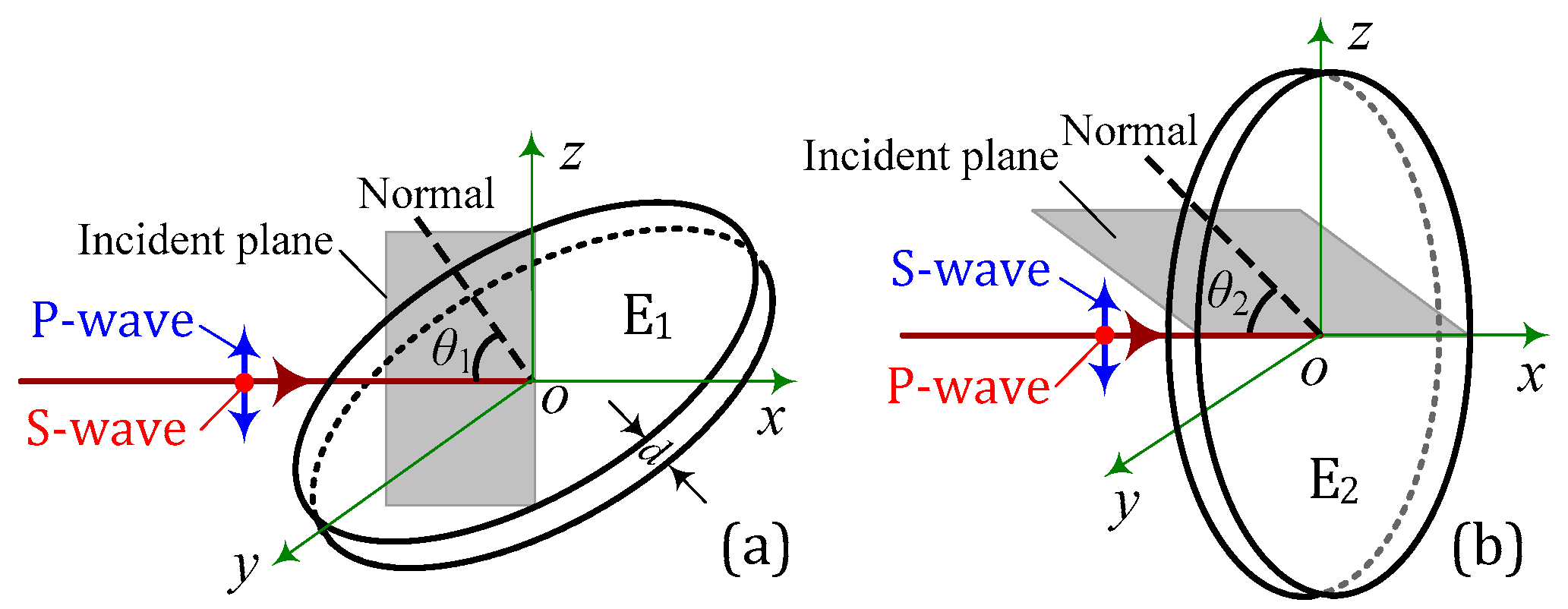



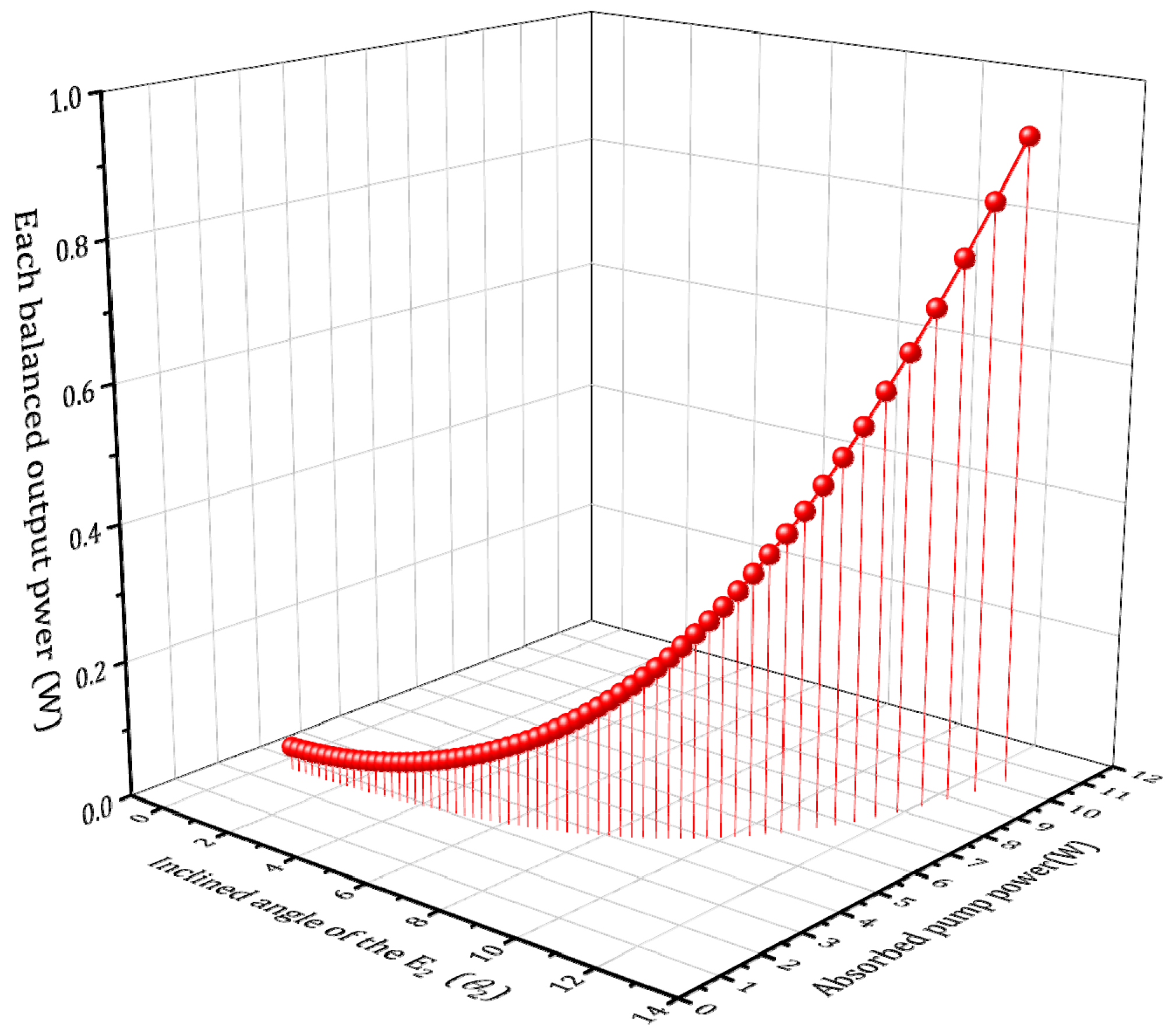
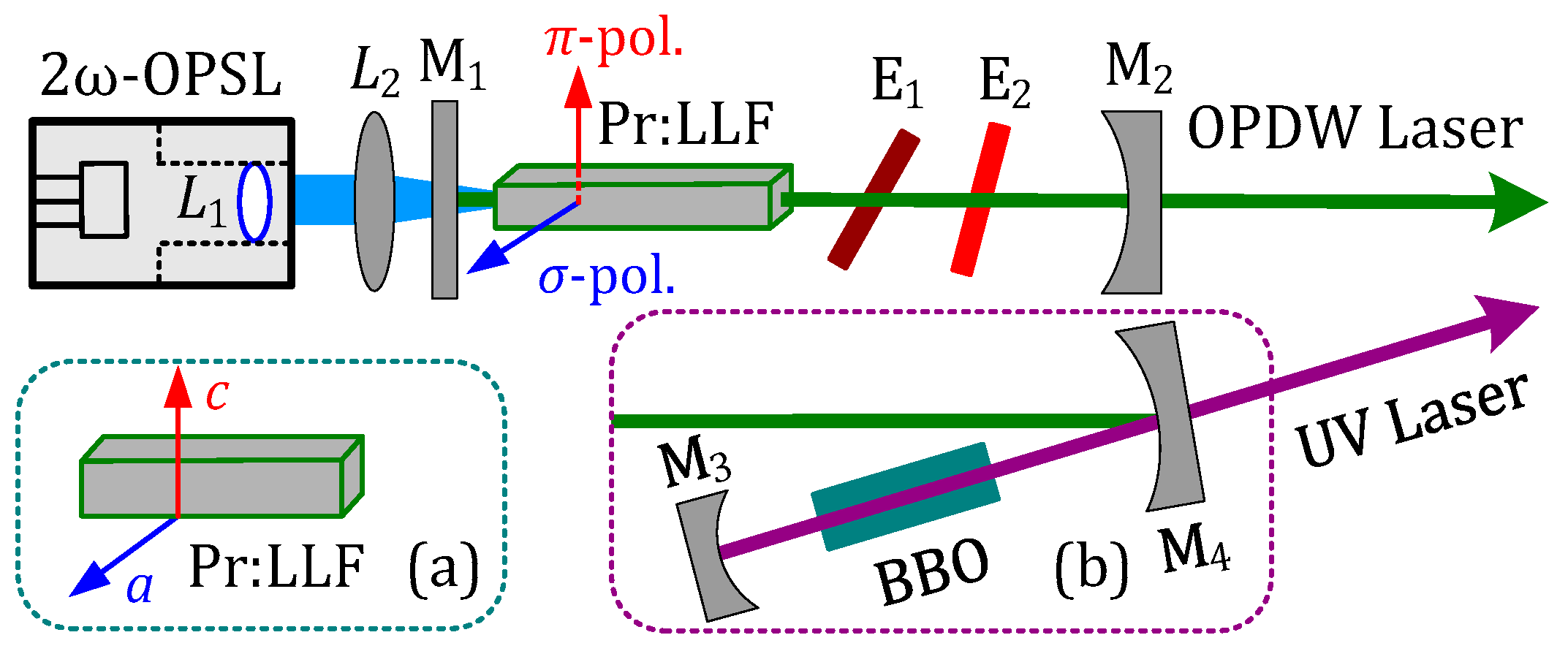
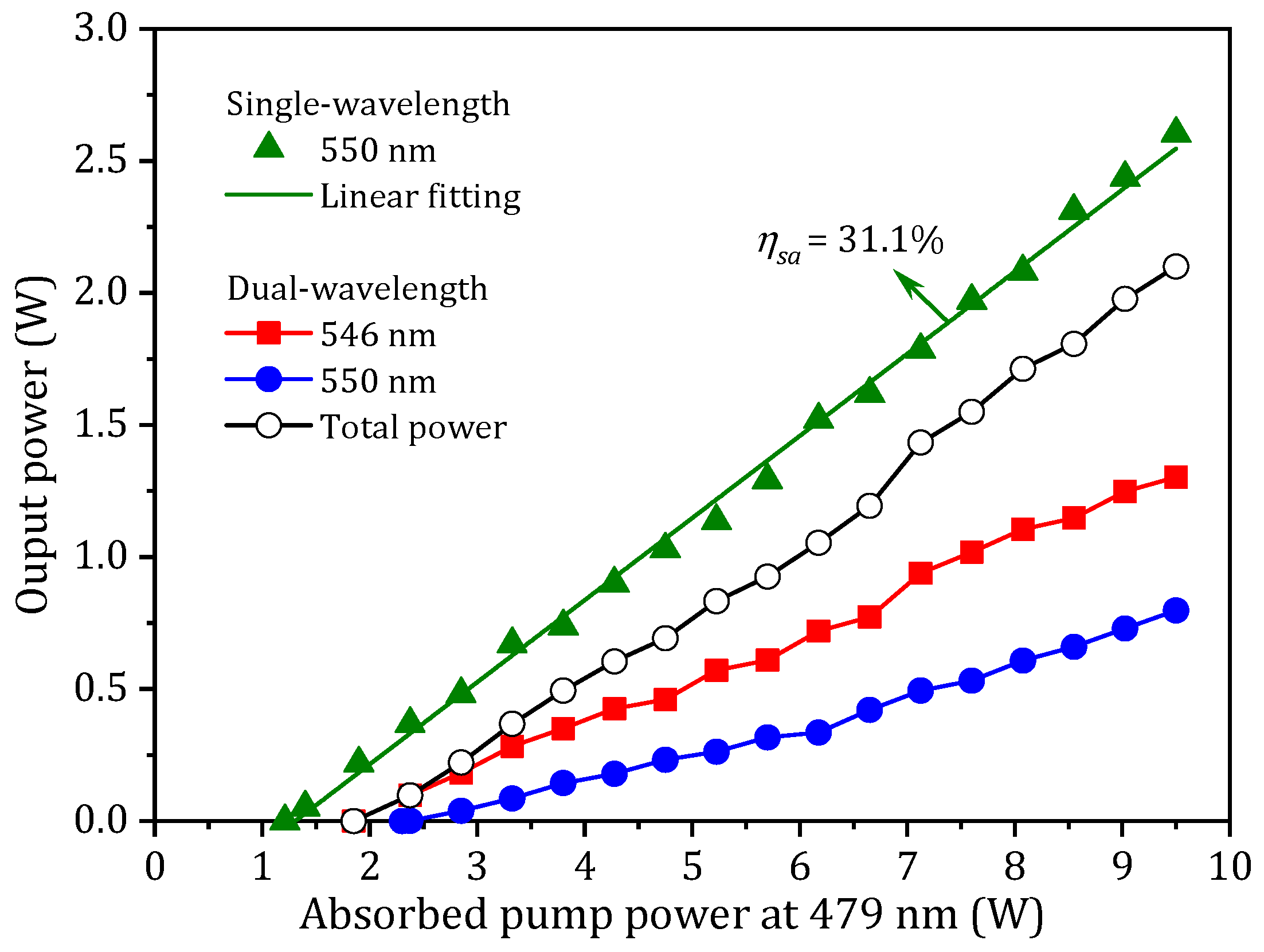
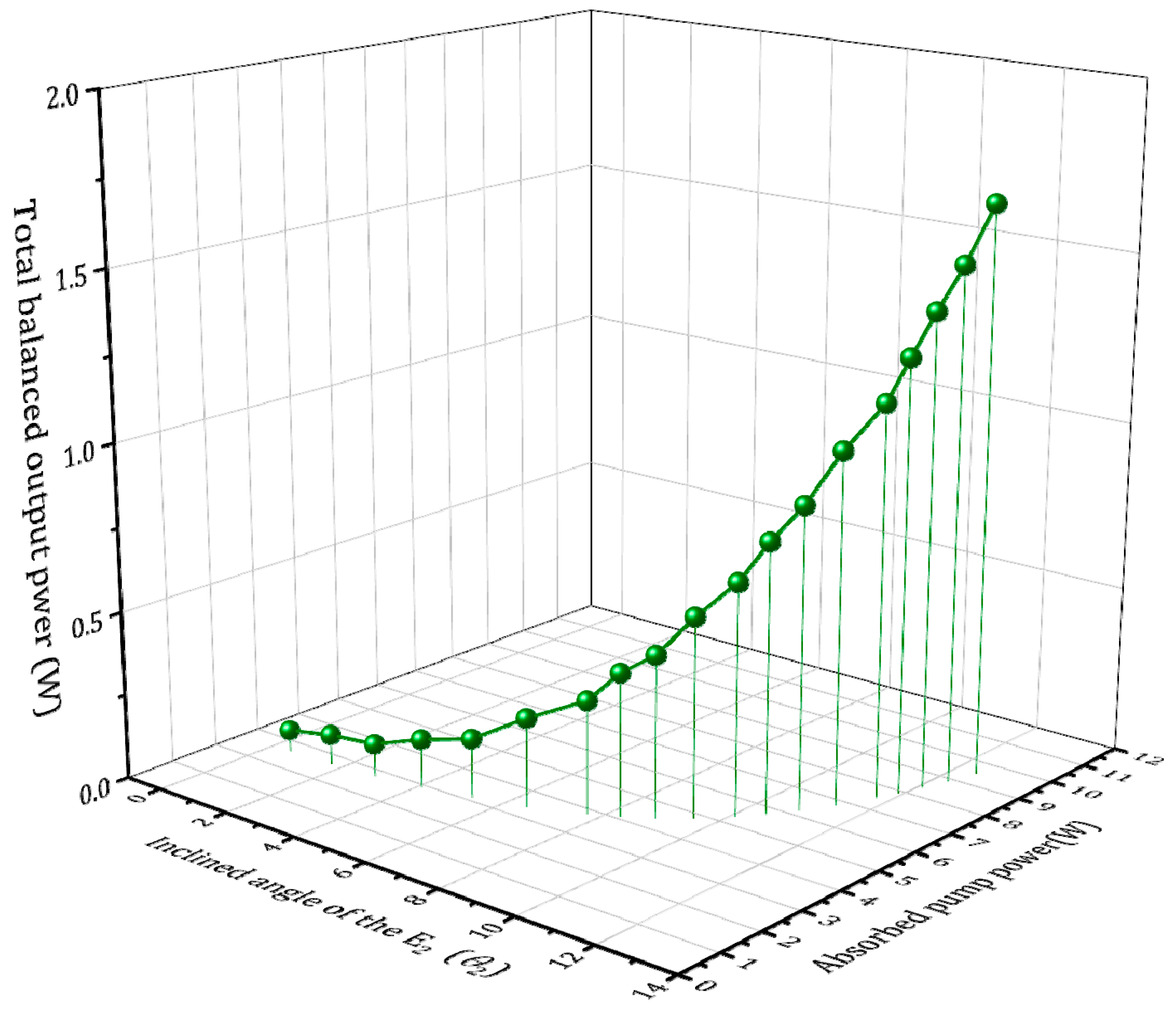


Disclaimer/Publisher’s Note: The statements, opinions and data contained in all publications are solely those of the individual author(s) and contributor(s) and not of MDPI and/or the editor(s). MDPI and/or the editor(s) disclaim responsibility for any injury to people or property resulting from any ideas, methods, instructions or products referred to in the content. |
© 2025 by the authors. Licensee MDPI, Basel, Switzerland. This article is an open access article distributed under the terms and conditions of the Creative Commons Attribution (CC BY) license (https://creativecommons.org/licenses/by/4.0/).
Share and Cite
Huang, H.; Xia, J.; Anh, N.; Li, Y.; Zhang, Y.; Zhang, Q.; Zhao, Z.; Lü, Y. Orthogonally Polarized Dual-Wavelength Pr:LLF Green Laser at 546 nm and 550 nm with the Balanced Output Powers at All Pump Power Level. Photonics 2025, 12, 393. https://doi.org/10.3390/photonics12040393
Huang H, Xia J, Anh N, Li Y, Zhang Y, Zhang Q, Zhao Z, Lü Y. Orthogonally Polarized Dual-Wavelength Pr:LLF Green Laser at 546 nm and 550 nm with the Balanced Output Powers at All Pump Power Level. Photonics. 2025; 12(4):393. https://doi.org/10.3390/photonics12040393
Chicago/Turabian StyleHuang, Haotian, Jing Xia, Nguyentuan Anh, Yuzhao Li, Yuanxian Zhang, Qian Zhang, Zhexian Zhao, and Yanfei Lü. 2025. "Orthogonally Polarized Dual-Wavelength Pr:LLF Green Laser at 546 nm and 550 nm with the Balanced Output Powers at All Pump Power Level" Photonics 12, no. 4: 393. https://doi.org/10.3390/photonics12040393
APA StyleHuang, H., Xia, J., Anh, N., Li, Y., Zhang, Y., Zhang, Q., Zhao, Z., & Lü, Y. (2025). Orthogonally Polarized Dual-Wavelength Pr:LLF Green Laser at 546 nm and 550 nm with the Balanced Output Powers at All Pump Power Level. Photonics, 12(4), 393. https://doi.org/10.3390/photonics12040393




